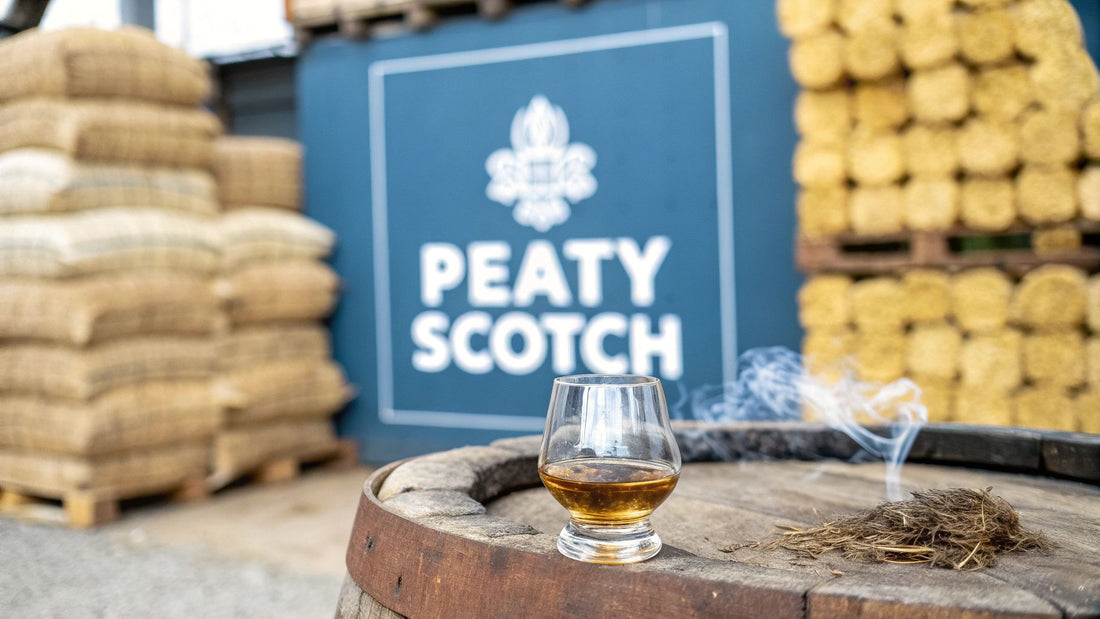When someone talks about a "peaty" scotch, they're referring to a whiskey that gets its signature smoky flavor from burning peat to dry out malted barley before distillation ever begins.
Imagine it like smoking meat on a barbecue. The aromatic smoke from the burning peat—which is basically compressed, decomposed plant matter—infuses the grain, lending it an incredible spectrum of bold, earthy flavors. This age-old method is responsible for one of the most polarizing, yet deeply beloved, styles in the entire world of whisky.
Your First Encounter with Smoky Scotch
If you're new to the world of scotch, the word "peaty" probably conjures images of a harsh, overwhelmingly smoky spirit. And while that full-on "campfire-in-a-glass" experience definitely exists, the reality is far more nuanced and interesting.
Peated scotch isn't just about smoke. It's a journey into a world of complex flavors—think damp earth after a rainstorm, salty sea air from the coast, and even medicinal notes that bring iodine or bandages to mind. It's a taste of the rugged Scottish landscape.
Historically, peat was just the most practical fuel source for drying barley, especially on remote Scottish islands like Islay where trees were few and far between. What started as a necessity born from geography eventually became a signature flavor profile.
Today, the intensity of that peat flavor is measured in parts per million (PPM) of phenols. This number can range from a gentle whisper of smoke to a powerful, all-encompassing bonfire. You can discover more insights about this process on Laphroaig.com. This measurement gives you a roadmap to what's waiting for you inside the bottle.
For anyone just starting their whiskey journey, finding the right entry point is the key to actually enjoying this unique spirit. You don't have to dive straight into the deep end with a peated monster. Starting with a more lightly peated expression lets your palate adjust and begin to pick up on all the subtle complexities hiding just behind the smoke. Understanding this spectrum will make your exploration far more rewarding. And if you're just getting your bearings, our complete guide to drinking scotch for beginners can help you build a solid foundation.
Tip for New Drinkers: A great peaty scotch tells a story of its origin. The smoke is just the first chapter, followed by tales of the sea, the land, and the hands that crafted it. Don't be afraid to start with something less intense.
To help you navigate this exciting category, let's break down the different peat levels and what they mean for the liquid in your glass. This quick guide will help you identify which style might be the perfect introduction for your palate.
A Quick Guide to Peat Levels
Understanding peat intensity, measured in Parts Per Million (PPM), and its common flavor profiles can help you find your perfect starting point. Think of this table as your field guide to finding a bottle you'll love.
| Peat Level | PPM Range (Approx.) | What to Expect in the Glass |
|---|---|---|
| Lightly Peated | 1-15 PPM | A gentle whisper of smoke, more earthy than fiery. Often has notes of heather, honey, and subtle campfire embers. Great for beginners. |
| Moderately Peated | 15-30 PPM | The smoke is more present but balanced. You'll find notes of smoldering wood, barbecue, and a hint of coastal brine or saltiness. |
| Heavily Peated | 30-50+ PPM | Bold, intense, and unmistakable. Expect powerful notes of bonfire smoke, iodine, seaweed, and a long, lingering finish. The classic "peat monster." |
Whether you start with a gentle wisp of smoke or jump right into the bonfire, exploring peated scotch is a journey worth taking. It's a style that rewards curiosity and an open mind.
From Ancient Bogs to Your Bottle
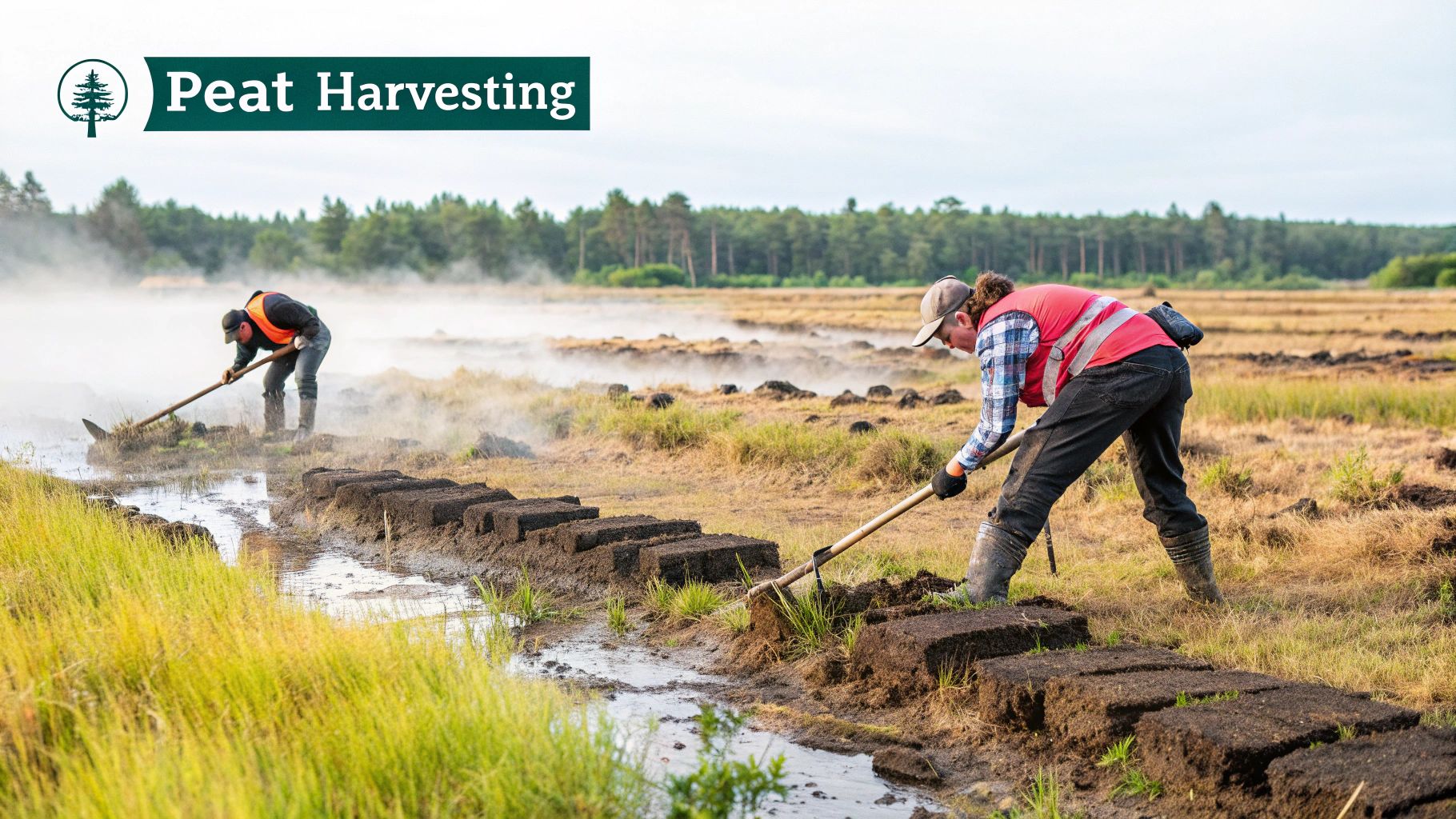
Before it ever imparts its signature smoke to a glass of whisky, peat spends thousands of years forming in Scotland's waterlogged bogs. This isn't just mud or dirt; it's a dense, organic material built up from millennia of slowly decaying moss, heather, and ancient grasses.
Think of it as nature's original fuel brick. For centuries, Scots would hand-cut these peat blocks, dry them out, and use them to heat their homes. More importantly for our story, they used it to fire the kilns that dry the malted barley for whisky production.
This ancient fuel is the very heart of what makes peated scotch so unique. The specific combination of plants that died and decomposed to create the peat directly shapes the character of the smoke, which in turn defines the final flavor of the spirit. It's a direct line from the land to the liquid.
As the peat smolders, its smoke bathes the damp barley, infusing the grain with chemical compounds called phenols. These phenols are what give the final whisky its famous smoky, medicinal, and earthy notes. To get a deeper dive into how peat levels are measured, The Whiskey Wash has a great breakdown.
Terroir in a Glass
The idea of terroir—how a product is shaped by the specific environment it comes from—is absolutely central to peated scotch. The makeup of peat changes dramatically across Scotland, creating a whole spectrum of smoky flavors.
- Coastal Peat: In places like Islay, the bogs are full of decomposed seaweed, salt-sprayed moss, and coastal heather. Burning this peat is what gives us those iconic medicinal, briny, and maritime notes of iodine and sea spray.
- Inland Peat: Head to the Highlands, and you'll find peat composed more of ancient trees, grasses, and heathery shrubs. The smoke here is often earthier, woodier, and can even carry sweet or floral undertones.
The smoke from peat isn't just one flavor; it's a complex fingerprint of the bog it came from. Every peated whisky offers a unique taste of a specific corner of Scotland, shaped by geology and time.
This direct connection from the bog to your bottle is what gives peaty scotch such a profound sense of place. Each sip is a taste of history, a liquid story of the ancient Scottish landscape.
How Distillers Craft That Smoky Flavor
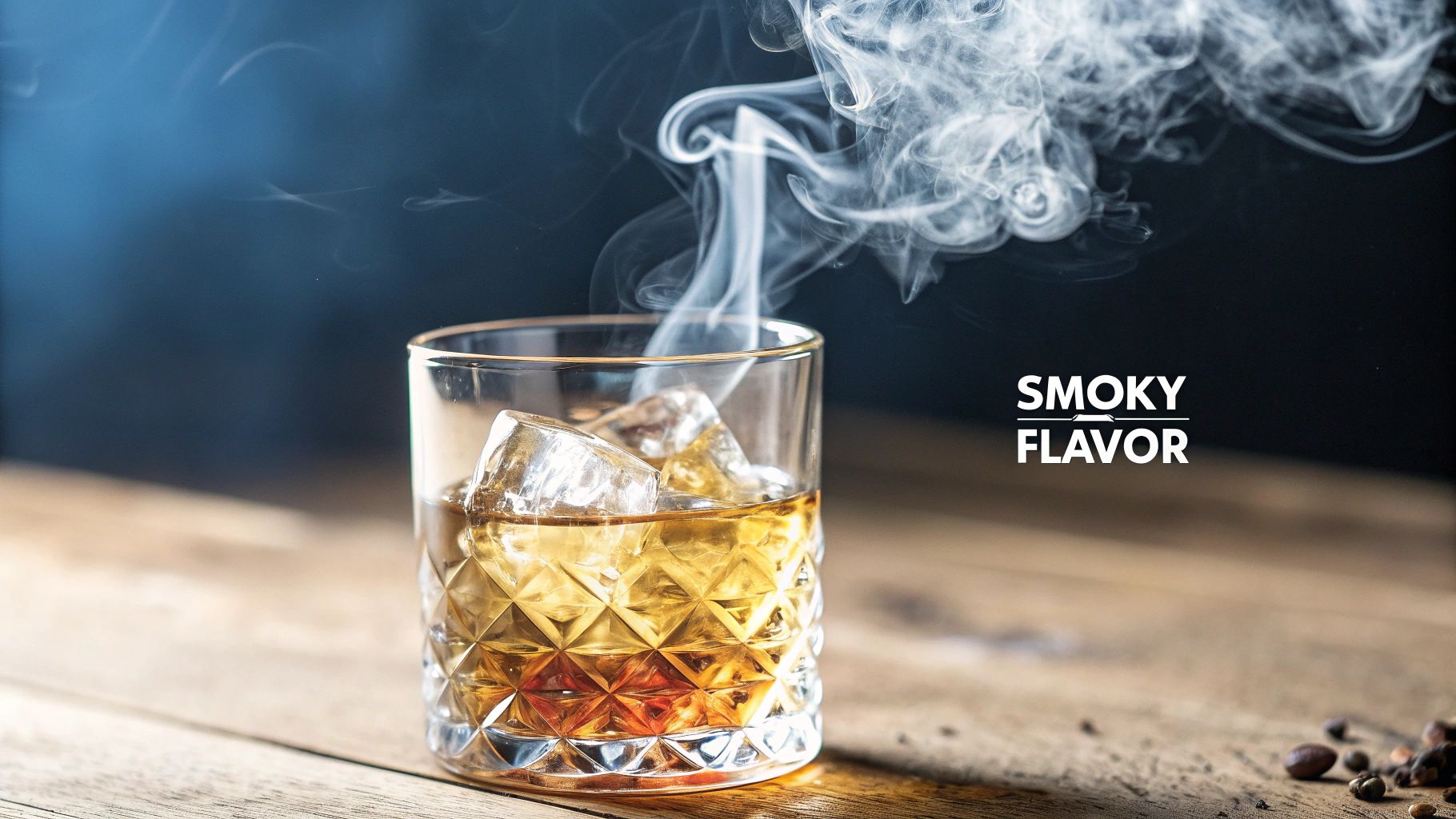
Turning ancient bog plants into one of whisky's most complex flavors is a time-honored blend of art and science. The real magic happens during the malting stage, inside a big, oven-like room known as a kiln.
This is where distillers spread out damp, germinated barley on a perforated floor. Below, a peat-fueled fire smolders away, sending thick, aromatic smoke billowing upwards. The phenol-rich smoke rises through the holes and completely envelops the moist grain, which eagerly soaks up all that quintessential smoky character.
Controlling the Smoke
The distiller’s hand is critical here. How long and how intensely the barley is exposed to the peat smoke directly dictates the final flavor of the whisky. A brief encounter creates a gently peated spirit, while a long, heavy smoke bath gives you a roaring "peat monster."
This whole process—malting the barley, then drying it over a peat fire—allows chemical compounds called phenols to infuse the grain. These compounds are hardy enough to survive the entire distillation process and define the spirit in your glass. This one step is the fork in the road for a whisky's entire profile. You can learn more about the difference between peated and unpeated whisky to see just how much it changes everything.
But the story doesn't end there. Aging plays a massive role in taming the smoke. A young, freshly distilled peated whisky can be like a bonfire in a glass—aggressive, raw, and unapologetically smoky. It’s an exciting dram, but it can be a lot for the uninitiated.
Tip for New Drinkers: Time in the cask is peat's great moderator. The sharp edges of the smoke soften, integrating with the sweet, vanilla, and caramel notes from the oak barrel. Don't be afraid to try an older peated scotch; it might be smoother than you think.
As the years tick by in the cask, that bonfire mellows into a warm, glowing hearth. The intense smokiness evolves, revealing deeper, more complex layers. An older peated scotch is often far more refined, with the smoke harmonizing beautifully with notes of fruit, spice, and oak for a truly unforgettable experience.
Exploring Scotland's Peated Whisky Regions
One of the first things you learn about peated Scotch is that not all smoke is created equal. Geography is the real puppet master here, and the specific spot where the peat was harvested and the whisky was made creates a massive difference in flavor. Think of it less as a single note and more as a complex regional dialect.
To really get a feel for the diverse landscape of peated whisky, it helps to understand the place it comes from. You can dive into Scotland's rich heritage to see just how deeply this spirit is woven into the country's fabric.
Let's start our virtual tour on Islay, the undisputed king of peat. Islay whiskies are legendary for their powerful, medicinal, and briny smoke. This comes from peat formed over millennia from coastal vegetation, which infuses the whisky with brash notes of iodine, seaweed, and salty sea spray. If you want a benchmark for this classic, in-your-face style, just look to distilleries like Ardbeg, Laphroaig, and Lagavulin.
This infographic breaks down the phenol levels—measured in Parts Per Million (PPM)—for three of Islay’s most iconic distilleries.
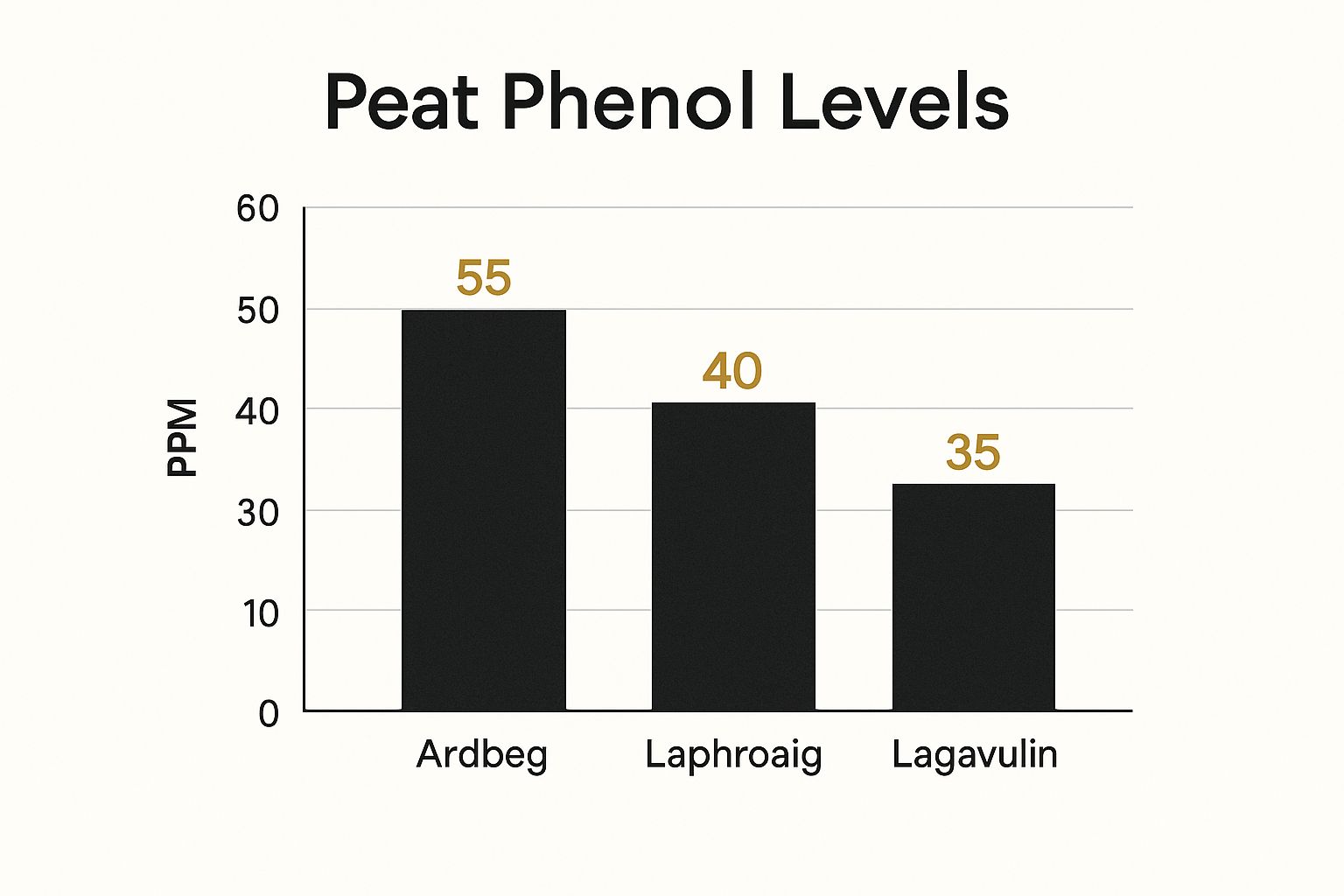
As you can see, Ardbeg really brings the thunder with a whopping 55 PPM. Laphroaig and Lagavulin aren't far behind, offering smoky profiles that are still incredibly potent but just a touch more restrained.
Beyond Islay's Smoky Shores
While Islay grabs most of the headlines, other regions offer their own unique spin on peated whisky. Each one provides a completely different tasting experience, making exploration a deeply rewarding journey for any whisky drinker.
This table provides a quick cheat sheet to the distinct peat profiles you'll find across Scotland's main whisky-producing regions.
Scotland's Peated Scotch Flavor Map
| Region | Dominant Peat Style | Common Flavor Notes | Classic Distillery Example |
|---|---|---|---|
| Islay | Maritime & Medicinal | Iodine, seaweed, brine, TCP | Ardbeg |
| The Highlands | Earthy & Floral | Heather, honey, damp earth, bonfire | Oban |
| The Islands | Coastal & Peppery | Sea salt, black pepper, light smoke | Taliskers |
| Campbeltown | Funky & Industrial | Engine oil, brine, damp wool | Springbank |
This map is just a starting point, of course. The real fun is in discovering the nuances and outliers that make each region—and each distillery—so unique.
Here’s a quick breakdown of what makes them different:
- The Highlands: The peat here is more inland, made up of decomposed wood and heather. This gives you a smoke that’s much earthier, sweeter, and sometimes beautifully floral. A dram from Oban perfectly showcases this gentle, complex peat character.
- The Islands: This diverse group—which includes Skye, Orkney, and Jura—delivers a fantastic balancing act of coastal brine and sweet, heathery smoke. Talisker, from the Isle of Skye, is the poster child for this style with its signature peppery kick and maritime notes.
- Campbeltown: Once the whisky capital of the world, Campbeltown is known for a funky, oily, and wonderfully robust peat style. A pour from Springbank will show you exactly what this unique, slightly industrial character is all about.
And the story doesn't end in Scotland. American craft distilleries are now getting in on the action, experimenting with local peat sources or smoking their grains with different woods like mesquite to create entirely new smoky profiles. Brands like Westland Distillery in Seattle and Corsair Distillery in Tennessee are proving that world-class smoky whiskey is being made right here in the USA.
How to Taste and Appreciate Peated Scotch
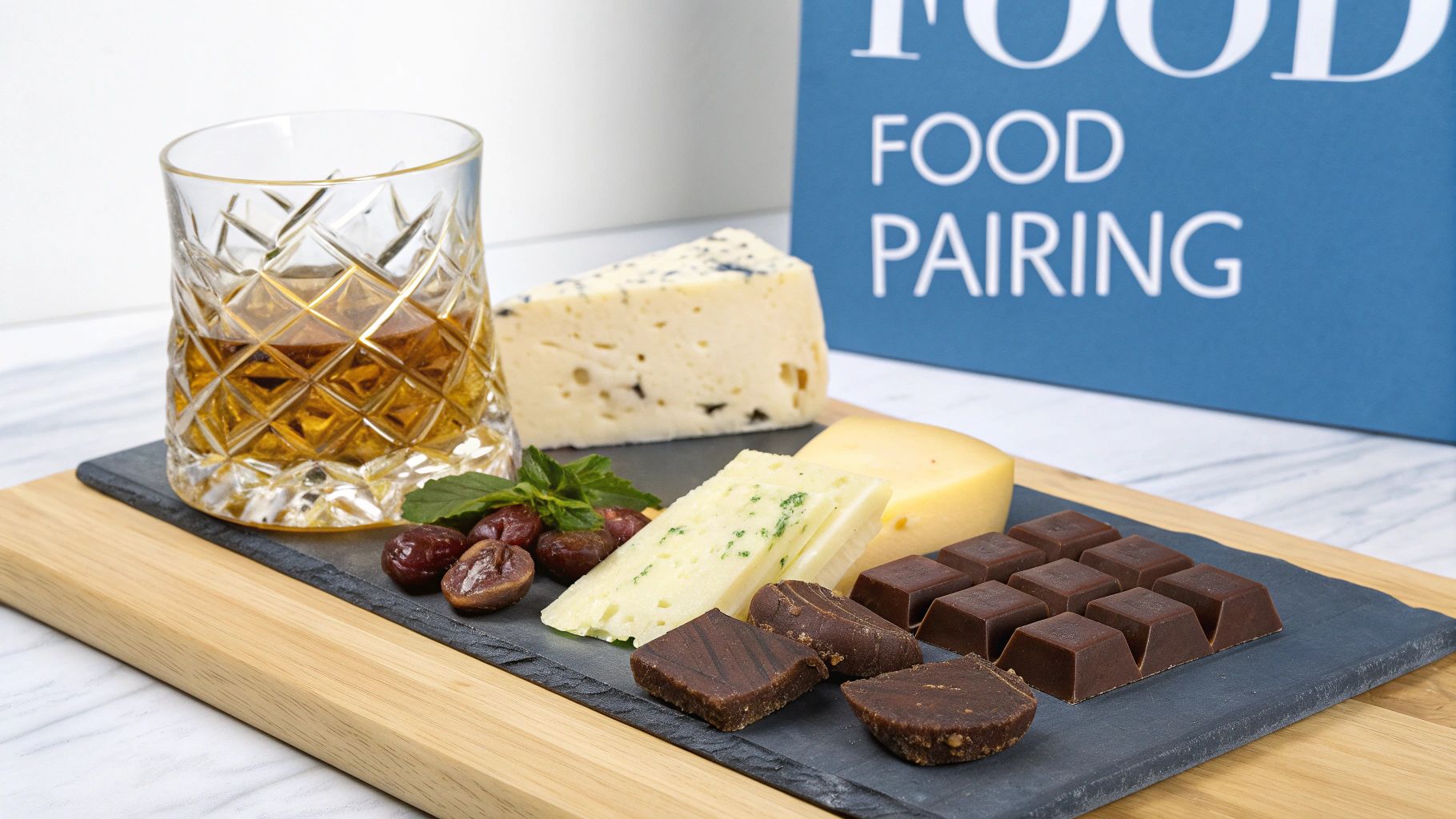
Let's be honest, staring down your first glass of peated scotch can feel a little intimidating. The key is to go slow. Give your nose and palate a minute to get acquainted with those big, smoky aromas before you even think about taking a sip.
Pour just a small amount into your glass and let it breathe for a few minutes. Give the glass a gentle swirl, but when you go to nose it, don't just dive right in—that's a recipe for sensory overload. Instead, keep the rim a few inches from your face and inhale softly through both your nose and mouth. This little trick helps you get past the initial wallop of alcohol and smoke, letting you hunt for the other notes hiding underneath.
The Magic of a Few Drops of Water
One of the first questions newcomers ask is about adding water or ice. While a cube of ice can be nice on a hot day, it’s a flavor killer. It numbs your taste buds and locks away many of the whisky’s more delicate, complex notes—and with a peated scotch, that’s a real shame.
Tip for New Drinkers: A few drops of room-temperature water is the single best trick for opening up a peated whisky. It dials back the alcohol just enough to soften the punch, allowing all those hidden aromas and flavors to step forward.
It’s amazing how this simple act can transform a dram from a roaring bonfire into a rich tapestry of sweet, salty, and earthy sensations. Try adding one drop at a time, tasting after each, until you find that sweet spot. If you really want to master the basics, our guide on how to taste whiskey is the perfect place to start: Blind Barrels.
Even American craft distilleries are now getting in on the action, releasing their own peated expressions and bringing exciting new profiles to the table. They’re experimenting with unique grain bills and maturation methods, proving just how much creative room there is within this smoky style.
Finding the Perfect Pairing
The right food doesn't just complement a peated scotch; it can completely elevate the experience. You’ll want to reach for bold flavors that have enough character to stand shoulder-to-shoulder with the whisky's intensity.
- Smoked Salmon: The rich, oily fish is a classic partner, playing beautifully with the salty, coastal notes found in so many peated whiskies.
- Strong Cheeses: Think aged cheddar, a funky blue cheese, or even a creamy goat cheese. The sharp, tangy flavors create a fantastic contrast with the smoke.
- Dark Chocolate: A quality piece of dark chocolate is a game-changer. It teases out the underlying sweetness in the scotch and provides a smooth, satisfying finish.
Peated Whiskies to Begin Your Journey
Ready to dive into the world of peaty scotch? Finding the right first bottle is everything—it’s the key to making sure your initial taste is an enjoyable one, not an overwhelming shock to the system.
For newcomers, the best approach is to start with what we call a "gateway peat." Think of it as a whisky with a balanced, approachable smokiness that introduces you to the style without completely taking over your palate. These drams let all the other fantastic flavors in the spirit have their moment to shine.
Gateway Peats for Beginners
- Talisker 10 Year: This is a brilliant starting point from the Isle of Skye. It serves up a wonderful balance of coastal brine, a crack of black pepper, and just the right amount of warming, moderate smoke.
- Bunnahabhain 12 Year: Though it hails from Islay, this one is only lightly peated. It leads with rich sherry notes of fruit and nuts, leaving just a gentle wisp of smoke lingering in the background. A perfect introduction.
Once you’ve gotten comfortable with those introductory notes, you might be ready for the full Islay experience. The classics are classics for a reason, delivering that bold, maritime smoke the island is so famous for.
Tip for New Drinkers: Venturing into peated whisky is a journey, not a race. Start with the approachable and work your way up to the iconic peat monsters to truly appreciate the spectrum of smoke.
If you feel like you're ready for a bigger challenge, these are the quintessential Islay heavy-hitters:
- Ardbeg 10 Year: A true peat monster. This one is all about bonfire smoke and zesty citrus, rounded out by a long, peppery finish that sticks with you.
- Laphroaig 10 Year: Famous (or infamous, depending on who you ask) for its distinct medicinal and iodine notes. It's a bold, unforgettable dram that defines the Islay style for many.
And don't think peat is just a Scottish game. For a modern twist, look to the American craft distillers who are putting their own spin on the style. Brands like Westland and Corsair are creating some seriously impressive peated single malts, offering a completely unique perspective on this old-world tradition.
For more guidance on tracking down your next great bottle, be sure to explore our extensive single malt whiskey recommendations.
Answering a Few Common Questions About Peaty Scotch
If you're just dipping your toes into the smoky side of scotch, you probably have a few questions. Let's clear up some of the most common points of confusion to get you tasting like a pro.
Does Peaty Scotch Just Taste Like Smoke?
Not even close. While smoke is definitely the headline act, it’s far from the only flavor in the show. The phenols from that burning peat create a foundation, sure, but on top of that, you’ll discover a whole world of complexity.
We’re talking about notes of damp earth, old leather, briny seaweed, iodine, and even savory hints of cured meat. Think of the smoke as just the first chapter in a much longer, more interesting story.
Is Peated Whisky Only Made in Scotland?
It used to be, but not anymore. While Scotland is the undisputed ancestral home of peated whisky, distillers all over the world have fallen in love with the style.
You can now find absolutely incredible peated whiskies coming out of Japan (like Yoichi), Ireland (Connemara is a classic), and even from innovative American craft distilleries like Westland out in Seattle.
Tip for New Drinkers: Age profoundly changes peated whisky. Younger expressions are often punchier and more intensely smoky. As the whisky spends decades in a cask, the smoke mellows and integrates with oak and fruit notes, becoming more complex and subtle. Neither is better; it's a matter of personal preference.
Are All Scotch Whiskies Peaty?
Absolutely not. In fact, the vast majority of all scotch whisky is completely unpeated.
Peated scotch is a very specific style that's most famously associated with the island of Islay. Many other regions, like Speyside, are world-renowned for their sweet, fruity, and floral whiskies that contain no smoke flavor whatsoever.
The best way to discover what you love is by tasting without bias. At Blind Barrels, we send you curated flights of top-shelf American craft whiskey to explore from the comfort of your home. Find your next favorite bottle based on taste, not labels. Start your blind tasting journey today!
